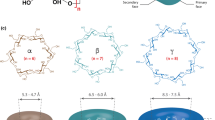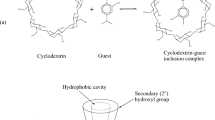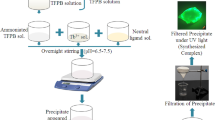Abstract
A new inclusion complex of β-cyclodextrin with sodium maleonitriledithiolate (Na2mnt) was investigated by electronic spectra, induced circular dichroism (ICD), and quantum mechanics (QM) methods. The orientation of the guest anion inside the host cavity was studied by ICD spectra and analyzed by structural optimization using PM3 quantum chemical method. Finally, the inclusion constant was determined by both a linear and a non-linear fitting methods, which were based on the variation of ICD signals of the guest upon inclusion complexation with the host. The inclusion constant of Na2mnt/β-cyclodextrin was estimated to be (2.45 ± 0.15) × 103 or (3.10 ± 0.11) × 103 M−1 in solution by these two fitting methods.







Similar content being viewed by others
References
Bender, M.L., Komiyama, M.: Cyclodextrin Chemistry. Springer, Berlin (1978)
(a) Ogino, H.: Relatively high-yield syntheses of rotaxanes. Syntheses and properties of compounds consisting of cyclodextrins threaded by α,ω-diaminoalkanes coordinated to cobalt (III) complexes. J. Am. Chem. Soc. 103, 1303–1304 (1981); (b) Wylie, R.S., Macartney, D.H.: Self-assembling metal rotaxane complexes of α-cyclodextrin. J. Am. Chem. Soc. 114, 3136–3138 (1992); (c) Liu, Y., Zhao, Y.L., Zhang, H.Y., Song, H.B.: Polymeric rotaxane constructed from the inclusion complex of β-cyclodextrin and 4,4′-dipyridine by coordination with nickel(II) ions. Angew. Chem. Int. Ed. 42, 3260–3263 (2003)
(a) Saenger, W.: Cyclodextrin inclusion compounds in research and industry. Angew. Chem. Int. Ed. 19, 344–362 (1980); (b) Wenz, G.: Cyclodextrins as building blocks for supramolecular structures and functional units. Angew. Chem. Int. Ed. 33, 803–822 (1994); (c) D’Souza, V.T., Lipkowitz, K.B.: Cyclodextrins. Chem. Rev. 98, 1741–2076 (1998)
Krois, D., Brinker, U.H.: Induced circular dichroism and UV–vis absorption spectroscopy of cyclodextrin inclusion complexes: structural elucidation of supramolecular azi-adamantane (spiro[adamantane-2,3′-diazirine]). J. Am. Chem. Soc. 120, 11627–11632 (1998)
(a) Schneider, H.-J., Hacket, F., Rüdiger, V., Ikeda, H.: NMR studies of cyclodextrins and cyclodextrin complexes. Chem. Rev. 98, 1755–1785 (1998); (b) Connors, K.A.: The stability of cyclodextrin complexes in solution. Chem. Rev. 97, 1325–1357 (1997)
(a) Harata, K., Uedaira, H.: The circular dichroism spectra of the β-cyclodextrin complex with naphthalene derivatives. Bull. Chem. Soc. Jpn. 48, 375–378 (1975); (b) Kodaka, M.: A general rule for circular dichroism induced by a chiral macrocycle. J. Am. Chem. Soc. 115, 3702–3705 (1993)
(a) King, R.B., Zipperer, W.C., and Ishaq, M.: Metal complexes of fluorophosphines. I. Reactions of cyclopentadienylmetal carbonyls with dialkylaminodifluorophosphines. Inorg. Chem. 11, 1361–1370 (1972); (b) Lu, C.S., Zhang, W.W., Ren, X.M., Hu, C.J., Zhu, H.Z., Meng, Q.J.: Intramolecular photo-substitution in the inclusion compound of mono[6-deoxy-6-(2-butenedinitrile-2,3-dimercapto sodium salt)]-beta-cyclodextrin with cyclopentadienyl manganese tricarbonyl in DMF solution. J. Chem. Soc., Dalton Trans. 3052–3055 (2001)
(a) Briggner, L.-E., Ni, X.-R., Tempesti, F., Wadsö, I.: Microcalorimetric titration of β-cyclodextrin with adamantane-1-carboxylate. Thermochim. Acta 109, 139–143 (1986); (b) Eftink, M.R., Andy, M.L., Bystrom, K., Perlmutter, H.D., Kristol, D.S.: Cyclodextrin inclusion complexes: studies of the variation in the size of alicyclic guests. J. Am. Chem. Soc. 111, 6765–6772 (1989)
Godinez, L.A., Schwartz, L., Criss, C.M., Kaifer, A.E.: Thermodynamic studies on the cyclodextrin complexation of aromatic and aliphatic guests in water and water–urea mixtures. Experimental evidence for the interaction of urea with arene surfaces. J. Phys. Chem. B 101, 3376–3380 (1997)
(a) Mwakibete, H., Bloor, D.M., Wyn-Jones, E.: Electrochemical studies of cationic drug inclusion complexes with α- and β-cyclodextrins. J. Inclusion Phenom. Macrocycl. Chem. 10, 497–505 (1991); (b) Bertrand, G.L., Faulkner, J.R., Han, S.M. Armstrong, D.W.: Substituent effects on the binding of phenols to cyclodextrins in aqueous solution. J. Phys. Chem. 93, 6863–6867 (1989); (c) Kinoshita, T., Iinuma, F., Tsuji, A.: Microanalysis of proteins and peptides. I. Enhancement of the fluorescence intensity of dansyl amino acids and dansyl proteins in aqueous media and its application to assay of amino acids and proteins. Chem. & Pharm. Bull. 22, 2413–2420 (1974); (d) Hamai, S.: Hydrogen bonding in inclusion complexes of heptakis(2,3,6-tri-O-methyl)-β-cyclodextrin with chlorophenols in organic solvents. Bull. Chem. Soc. Jpn. 65, 2323–2327 (1992); (e) Lewis, E.A., Hansen, L.D.: Thermodynamics of binding of guest molecules to α- and β-cyclodextrins. J. Chem. Soc., Perkin Trans. 2, 2081–2085 (1973); (f) Siimer, E., Kobu, M., Kurvits, M.: Thermochemical study of cyclodextrin inclusion complexes. Thermochim. Acta 170, 89–95 (1990); (g) Siimer, E., Kurvits, M., Kostner, A.: Thermochemical investigation of β-cyclodextrin complexes with benzoic acid and sodium benzoate. Thermochim. Acta 116, 249–256 (1987)
Cramer, F., Saenger, W., Spatz, H.C.: Inclusion compounds. XIX.1a The formation of inclusion compounds of α-cyclodextrin in aqueous solutions. Thermodynamics and kinetics. J. Am. Chem. Soc. 89, 14–20 (1967)
Liu, L., Song, K.S., Li, X.S., Guo, Q.X.: Charge-transfer interaction: a driving force for cyclodextrin inclusion complexation. J. Inclusion Phenom. Macrocycl. Chem. 40, 35–39 (2001)
Gaussian 03 (Revision B.03); Frisch, M.J.G., Trucks, W., Schlegel, H.B., Scuseria, G.E., Robb, M.A., Cheeseman, J.R., Montgomery, J.A. Jr., Vreven, T., Kudin, K.N., Burant, J.C., Millam, J.M., Iyengar, S.S., Tomasi, J., Barone, V., Mennucci, B., Cossi, M., Scalmani, G., Rega, N., Petersson, G.A., Nakatsuji, H., Hada, M., Ehara, M., Toyota, K., Fukuda, R., Hasegawa, J., Ishida, M., Nakajima, T., Honda, Y., Kitao, O., Nakai, H., Klene, M., Li, X., Knox, J.E., Hratchian, H.P., Cross, J.B., Adamo, C., Jaramillo, J., Gomperts, R., Stratmann, R.E., Yazyev, O., Austin, A.J., Cammi, R., Pomelli, C., Ochterski, J.W., Ayala, P.Y., Morokuma, K., Voth, G.A., Salvador, P., Dannenberg, J.J., Zakrzewski, V.G., Dapprich, S., Daniels, A.D., Strain, M.C., Farkas, O., Malick, D.K., Rabuck, A.D., Raghavachari, K., Foresman, J.B., Ortiz, J.V., Cui, Q., Baboul, A.G., Clifford, S., Cioslowski, J., Stefanov, B.B., Liu, G., Liashenko, A., Piskorz, P., Komaromi, I., Martin, R.L., Fox, D.J., Keith, T., Al-Laham, M.A., Peng, C.Y., Nanayakkara, A., Challacombe, M., Gill, P.M.W., Johnson, B., Chen, W., Wong, M.W., Gonzalez, C, Pople, J.A.: Gaussian Inc., Pittsburgh, PA, USA (2003)
(a) Liu, L., Guo, Q.X.: Use of quantum chemical methods to study cyclodextrin chemistry. J. Inclusion Phenom. Macrocycl. Chem. 50, 95–103 (2004); (b) Muller, A., Wenz, G.: Thickness recognition of bolaamphiphiles by α-cyclodextrin. Chem. Eur. J. 13, 2218–2223 (2007)
(a) Zhang, X., Nau, W.M.: Chromophore alignment in a chiral host provides a sensitive test for the orientation—intensity rule of induced circular dichroism. Angew. Chem. Int. Ed. Engl. 39, 544–547 (2000); (b) Bobek, M.M., Krois, D., Brinker, U.H.: Induced circular dichroism of cyclodextrin inclusion complexes: examining the cavity with a bilateral probe. Org. Lett. 2, 1999–2002 (2000); (c) Mieusset, J.L., Krois, D., Pacar, M., Brecker, L., Giester, G., Brinker, U.H.: Supramolecular recognition and structural elucidation of inclusion complexes of an achiral carbene precursor in beta and permethylated β-cyclodextrin. Org. Lett. 6, 1967–1970 (2004); (d) Mayer, B., Zhang, X.Y., Nau, W.M., Marconi, G.: Co-conformational variability of cyclodextrin complexes studied by induced circular dichroism of azoalkanes. J. Am. Chem. Soc. 123, 5240–5248 (2001); (e) Bakirci, H., Zhang, X.Y., Nau, W.M.: Induced circular dichroism and structural assignment of the cyclodextrin inclusion complexes of bicyclic azoalkanes. J. Org. Chem. 70, 39–46 (2005)
Bähr, G., Schleitzer, G.: Carbon disulfide and carbon diselenide. II. The condensing and spontaneous desulfidizing of salts and esters of cyanodithioformic acid. Free cyanodithioformic acid. Chem. Ber. 90, 438–443 (1957)
Lu, Z.D., Lu, C.S., Meng, Q.J.: unpublished results
Nowakowska, M., Smoluch, M., Sendor, D.: The effect of cyclodextrins on the photochemical stability of 7-amino-4-methylcoumarin in aqueous solution. J. Inclusion Phenom. Macrocycl. Chem. 40, 213–219 (2001)
Acknowledgements
This work was supported by the National Natural Science Foundation (No. 20490218) and the Nanjing University Talent Development Foundation.
Author information
Authors and Affiliations
Corresponding author
Rights and permissions
About this article
Cite this article
Lu, Z., Lu, C. & Meng, Q. An inclusion complex of β-cyclodextrin with mnt anion (mnt = maleonitriledithiolate) studied by induced circular dichroism. J Incl Phenom Macrocycl Chem 61, 101–106 (2008). https://doi.org/10.1007/s10847-007-9400-6
Received:
Accepted:
Published:
Issue Date:
DOI: https://doi.org/10.1007/s10847-007-9400-6




